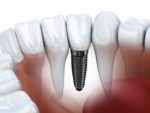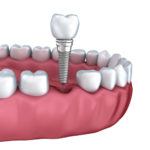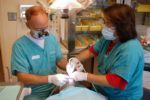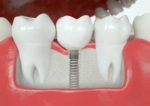To decide whether implants are right for you, it is necessary to consult with your dentist, a specialist in oral surgery and/or prosthetic. Dental implant procedure is one of the more complicated procedures in dentistry.
During this review, the dentist will carefully examine your teeth and gums and assess the density and the amount of bone. It may be necessary to do Ortopan or CBCT scans (3D panoramic X) to ensure that there is adequate bone structure and to determine exactly where it should be placed. Prosthetist will in turn determine the best way to set it in order to ensure a good final restoration.
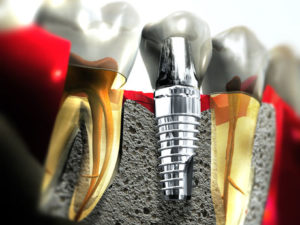
Based on the state of your oral tissues, oral hygiene and personal habits, as well as the commitment to follow subsequent instructions, dentist will advise you on the most appropriate treatment plan. Some patients, with inadequate bone structure will first have to do the upgrade of bones and may use implants of smaller diameter, the so-called mini implants.
Depending on your situation, dentist will explain to you how long the entire process will take, how often will it be necessary for you to go to the office and what can you expect after each procedure.
The crowns on them are virtually indistinguishable from other teeth, due to structural and functional connection between it and the bone itself. Placing it, to compensate for the missing tooth, can be done at any age after puberty when bone growth is complete. After placing it at precisely the right place follows the period of osseointegration. 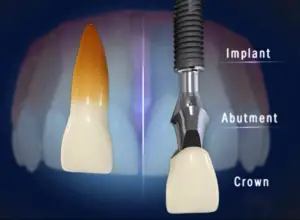 Osseointegration is a process in which the implant solidifies, ie. coalesce with the bones. They need around two to three months to consolidate and accrete, after which the treatment ends with upgrading crown.
Osseointegration is a process in which the implant solidifies, ie. coalesce with the bones. They need around two to three months to consolidate and accrete, after which the treatment ends with upgrading crown.
When the dentists refer to them they usually think only of titanium screw that is embedded into the jaw. However, on that screw is placed crown carrier (abutment) and over that the dental crown or bridge.
Dental implant procedure:
- Planning implant is done with the help of panoramic radiographs or even better CBCT scan and at this stage the experience of doctors is very important and a good knowledge of the anatomy and structure of the jaw bone, to avoid nerve injury or sinuses.
- The patient is given a local anesthetic that numbs the place on which it will be placed.
- On that spot a small incision is made on the gums and it is lifted to gain access to the jaw on which it will be placed.
- By using special instruments (burs) bone preparation is done and preparing of the spot for placing it. The intended spot will be slowly expanded by burs, whose diameter gradually increases. This will make adequate space for titanium screw (implant) to replace the tooth root.
- It is screwed manually into the bay, and then tightened by special key, to provide the necessary stability.
- Lifted gingiva is returned into place and connected back with a few stitches. You will be prescribed analgetics to take home with you.
- After a few months, it has adhered to the bone and gingiva is removed to access it in order to take an impression for the crown.
- To its special part (abutment) is screwed , which serves the carrier of the crown.
- The crown, in almost every visit, is tried out with abutment, in order to ensure ideal fitting of the dental arch.
- Definitely made and glazed crown is set (by cementing or screwing) on the abutment which is already attached to it, and thus the treatment is completed.
And that will conclude the dental implant procedure.

